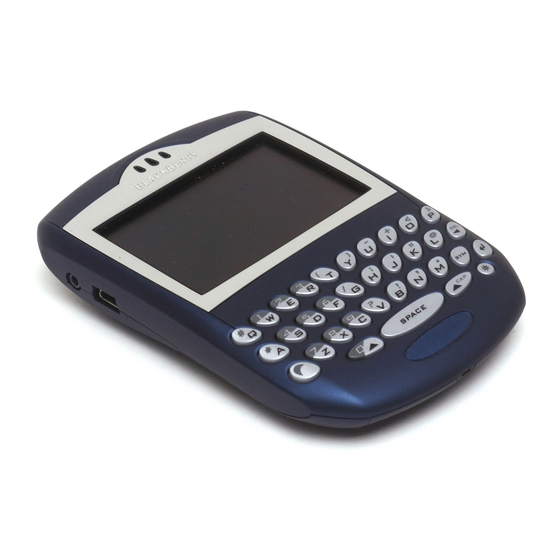Blackberry 7290 WIRELESS HANDHELD - SAFETY AND Informasi Produk - Halaman 6
Jelajahi secara online atau unduh pdf Informasi Produk untuk Perangkat genggam Blackberry 7290 WIRELESS HANDHELD - SAFETY AND. Blackberry 7290 WIRELESS HANDHELD - SAFETY AND 10 halaman. Blackberry internet service user guide
Juga untuk Blackberry 7290 WIRELESS HANDHELD - SAFETY AND: Informasi Keamanan dan Produk (10 halaman), Panduan Memulai (11 halaman), Panduan Memulai (28 halaman), Panduan Pengguna (9 halaman)

Safety and Product Information
Additional safety guidelines
Liquids and foreign objects: Never push objects of any kind into the handheld or handheld
accessories through openings as this action might short circuit parts and cause a fire or electric shock.
Do not use the handheld or handheld accessories near water (for example, near a bathtub or a sink, in a
wet basement, or near a swimming pool). Never spill liquid of any kind on the handheld or handheld
accessories.
Stability: Do not place the handheld or handheld accessory on any unstable surface. It could fall,
thereby potentially causing serious injury to a person and serious damage to the handheld or handheld
accessory. Take care when using the handheld with any charging accessories to route the power cord in
a way that reduces the risk of injury to others, such as by tripping or choking.
Cleaning: Do not use liquid, aerosol cleaners, or solvents on or near the handheld or handheld
accessory. Clean only with a dry cloth. Disconnect any cables from the computer and unplug any
charging accessories from the electrical outlet before cleaning either the handheld or the charging
accessory.
Compliance information
Exposure to radio frequency signals
The BlackBerry Wireless Handheld is a low power radio transmitter and receiver. When the handheld
radio is on, it receives and also sends out RF signals. The handheld complies with U.S. Federal
Communications Commission (FCC), Industry Canada (IC), and European Union (EU) guidelines
respecting safety levels of RF exposure for wireless handheld devices, which in turn are consistent with
the following safety standards previously set by Canadian, U.S., and international standards bodies:
• ANSI/IEEE C95.1, 1999, IEEE Standard for Safety Levels with Respect to Human Exposure to Radio
Frequency Electromagnetic Fields, 3 kHz to 300 GHz
• National Council on Radiation Protection and Measurements (NCRP) Report 86, 1986, Biological
Effects and Exposure Criteria for Radio Frequency Electromagnetic Fields
• Health Canada, Safety Code 6, 1999, Limits of Human Exposure to Radio Frequency
Electromagnetic Fields in the Frequency Range from 3 kHz to 300 GHz
• EN 50360, 2001, Product standard to demonstrate the compliance of mobile phones with the basic
restrictions related to human exposure to electromagnetic fields (300 MHz to 3 GHz)
• International Commission on Non-Ionizing Radiation Protection (ICNIRP), 1998, Guidelines for
limiting exposure to time-varying electric, magnetic, and electromagnetic fields (up to 300 GHz)
• Official Journal of the European Union, 1999, Council Recommendation of 12 July 1999 on the
limitation of exposure of the general public to electromagnetic fields (0 Hz to 300 GHz)
To maintain compliance with FCC, IC, and EU RF exposure guidelines when carrying the handheld on
your body, use only RIM-supplied or approved accessories. Use of accessories that are not approved by
RIM might violate FCC, IC, and EU RF exposure guidelines and might void any warranty applicable to
the handheld. When carrying the handheld while the radio is on, use the specific RIM-approved
holster that has been tested for compliance. For data operation (when you do not use a body-worn
accessory and are not holding the handheld at the ear), position the handheld at least 15mm (0.60
inches) from the body.
Specific absorption rate data
THIS MODEL WIRELESS HANDHELD MEETS GOVERNMENT REQUIREMENTS FOR
EXPOSURE TO RADIO WAVES.
6
